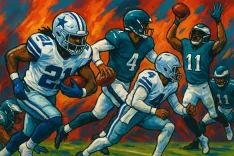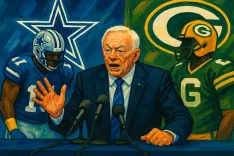Key Player Considerations for Fantasy Football Managers in the 2025 NFL Season

Fantasy football managers preparing for the 2025 NFL season typically enter their draft rooms with specific players in mind to target. Alongside these desired selections, it is equally important to identify players to avoid at their current draft costs. While acquiring a potential league-winner can significantly enhance a team’s chances of success, steering clear of first-round failures and early draft flops can be just as vital in achieving a championship. Given that running backs often face the highest attrition rates, it is prudent to highlight three noteworthy players at this critical position who present considerable cautionary flags.
Christian McCaffrey's potential remains both apparent and highly appealing. If he manages to maintain his health throughout the season, he could emerge as the premier player in fantasy leagues. Unfortunately, the corresponding downside to this scenario is equally evident. The caveat of 'if healthy' is particularly relevant for McCaffrey, who has been limited to seven games or fewer in three of the past five seasons. In 2024, he registered only four appearances, while his participation was restricted to three games back in 2020. As he approaches his 30th birthday—a milestone often considered precarious for running backs—concerns about his efficacy deepen. His previous season was one of his least productive, as evidenced by his 5.4 yards per touch, which marked the second-lowest average of his career. Furthermore, for the first time, he failed to record a score during the season. While his potential is undeniably compelling, it raises questions about the wisdom of drafting him in the first round given these significant risks.
Javonte Williams's performance in the previous season looks impressive on the surface, as only five running backs outperformed him in standard fantasy points. However, a deeper examination reveals that his campaign was contingent upon a notably high volume of opportunities, which raises concern about future performance should those opportunities diminish. Williams's average of 4.7 yards per touch in his initial seasons dropped to a career-low of 4.2 yards in the past season. Although the Los Angeles Rams have not heavily invested in alternative running back options and recently extended Williams's contract, there is the possibility that the team may seek increased explosiveness in their running game. His lack of elusive qualities and production of explosive plays contribute to concerns that he could struggle in the upcoming season, potentially placing managers in a challenging situation if they invest a second or third-round pick on him.
The discussion around Breece Hall invites further scrutiny regarding his production as a running back. A 1,000-yard rushing season for a premier back may not hold the same significance it once did; for those playing all 17 games, reaching that mark could require just under 60 rushing yards per week—barely scratching the surface of elite performance. Hall has yet to achieve a 1,000-yard season or a double-digit touchdown campaign, which raises pivotal questions regarding his value. While some analysts may argue that Hall enhances his worth through his contributions in the passing game, concerns arise about his ability to maintain that efficiency when receiving passes from Chicago Bears' quarterback Justin Fields. Notably, Fields has a career completion percentage of 61.1, having played more games (50) than he has thrown touchdowns (45). Compounding this issue is the potential for reduced rushing opportunities for Hall, given Fields's dual-threat capabilities. Furthermore, Jets head coach Aaron Glenn has indicated a preference for utilizing a committee approach with their running backs, suggesting that Hall's volume may not be sufficient to justify his average third-round draft cost.









